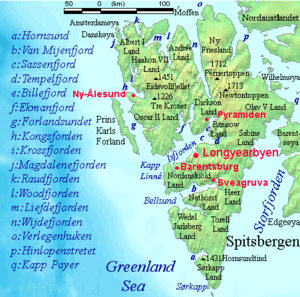
Hamburgbukta
Encyclopedia
Hamburgbukta is a one-kilometer-long bay on the western side of Hoelhalvøya, Albert I Land
, Spitsbergen
in the Svalbard
archipelago.

were the first to occupy it in 1633, calling it Port Louis or Refuge Français. On the southern shore of the bay they built a whaling
station. In 1634 two English
men-of-war tried to drive out the French, but failed. In 1637 they were driven out of Hamburgbukta by the Danes
. They abandoned it in the following year after being harassed by the Danes once more. It was named Ulfeldts Bay by the Danes, in honor of Corfits Ulfeldt
, who was responsible for driving away the French in 1637-38. In 1644 the first Hamburg
ships came to the bay. They came to the bay again in 1648, and in later years, which resulted in the bay being named after the German
port (which was part of Denmark at the time).
Later the bay was used by Russian
trappers. In 1818, a British
expedition, while anchored in Magdalenefjorden
, which lies just to the north, they met Russian hunters from Hamburgbukta. One of the British officers went with them to the bay, where he found that they had built "a comfortable wooden hut, well lined with moss, divided into three compartments".
Albert I Land
Albert I Land is the land area of the northwestern part of Spitsbergen, Svalbard, bordering to Haakon VII Land.The area is named after Albert I, Prince of Monaco.Albert I Land is the part of Spitsbergen that was first observed by Willem Barentz in 1596...
, Spitsbergen
Spitsbergen
Spitsbergen is the largest and only permanently populated island of the Svalbard archipelago in Norway. Constituting the western-most bulk of the archipelago, it borders the Arctic Ocean, the Norwegian Sea and the Greenland Sea...
in the Svalbard
Svalbard
Svalbard is an archipelago in the Arctic, constituting the northernmost part of Norway. It is located north of mainland Europe, midway between mainland Norway and the North Pole. The group of islands range from 74° to 81° north latitude , and from 10° to 35° east longitude. Spitsbergen is the...
archipelago.

History
The FrenchFrance
The French Republic , The French Republic , The French Republic , (commonly known as France , is a unitary semi-presidential republic in Western Europe with several overseas territories and islands located on other continents and in the Indian, Pacific, and Atlantic oceans. Metropolitan France...
were the first to occupy it in 1633, calling it Port Louis or Refuge Français. On the southern shore of the bay they built a whaling
History of whaling
The history of whaling is very extensive, stretching back for millennia. This article discusses the history of whaling up to the commencement of the International Whaling Commission moratorium on commercial whaling in 1986....
station. In 1634 two English
England
England is a country that is part of the United Kingdom. It shares land borders with Scotland to the north and Wales to the west; the Irish Sea is to the north west, the Celtic Sea to the south west, with the North Sea to the east and the English Channel to the south separating it from continental...
men-of-war tried to drive out the French, but failed. In 1637 they were driven out of Hamburgbukta by the Danes
Denmark
Denmark is a Scandinavian country in Northern Europe. The countries of Denmark and Greenland, as well as the Faroe Islands, constitute the Kingdom of Denmark . It is the southernmost of the Nordic countries, southwest of Sweden and south of Norway, and bordered to the south by Germany. Denmark...
. They abandoned it in the following year after being harassed by the Danes once more. It was named Ulfeldts Bay by the Danes, in honor of Corfits Ulfeldt
Corfits Ulfeldt (naval officer)
Corfits Mogensen Ulfeldt was a Danish naval officer, a cousin of the much more famous traitor Corfitz Ulfeldt . He is known in the annals of whaling as the man who drove the French out of Spitsbergen...
, who was responsible for driving away the French in 1637-38. In 1644 the first Hamburg
Hamburg
-History:The first historic name for the city was, according to Claudius Ptolemy's reports, Treva.But the city takes its modern name, Hamburg, from the first permanent building on the site, a castle whose construction was ordered by the Emperor Charlemagne in AD 808...
ships came to the bay. They came to the bay again in 1648, and in later years, which resulted in the bay being named after the German
Germany
Germany , officially the Federal Republic of Germany , is a federal parliamentary republic in Europe. The country consists of 16 states while the capital and largest city is Berlin. Germany covers an area of 357,021 km2 and has a largely temperate seasonal climate...
port (which was part of Denmark at the time).
Later the bay was used by Russian
Russia
Russia or , officially known as both Russia and the Russian Federation , is a country in northern Eurasia. It is a federal semi-presidential republic, comprising 83 federal subjects...
trappers. In 1818, a British
United Kingdom
The United Kingdom of Great Britain and Northern IrelandIn the United Kingdom and Dependencies, other languages have been officially recognised as legitimate autochthonous languages under the European Charter for Regional or Minority Languages...
expedition, while anchored in Magdalenefjorden
Magdalenefjorden
Magdalenefjorden is an 8 km long and up to 5 km wide fjord between Reuschhalvøya and Hoelhalvøya, Albert I Land, on the west coast of Spitsbergen, the largest island in the Svalbard archipelago.-History:...
, which lies just to the north, they met Russian hunters from Hamburgbukta. One of the British officers went with them to the bay, where he found that they had built "a comfortable wooden hut, well lined with moss, divided into three compartments".

